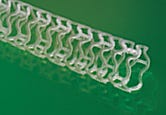The global market for bioabsorable scaffolds (BAS) is poised for rapid growth, expanding from $143.7 million in 2014 to more than $2 billion by 2021, according to a new study from London-based market research firm GlobalData. The impressive 42.1% compound annual growth rate will be driven by uptake of the minimally invasive technology in Europe, the United States, Japan, Brazil, China and India.Although no BAS devices have been approved thus far by FDA, four CE-marked products are available in the European Union and other countries that recognize the marking.
July 25, 2015
The global market for bioabsorable scaffolds (BAS) is poised for rapid growth, expanding from $143.7 million in 2014 to more than $2 billion by 2021, according to a new study from London-based market research firm GlobalData. The impressive 42.1% compound annual growth rate will be driven by uptake of the minimally invasive technology in Europe, the United States, Japan, Brazil, China and India.
Although no BAS devices have been approved thus far by FDA, four CE-marked products are available in the European Union and other countries that recognize the marking.
BAS products are defined in the GlobalData report as fully bioabsorbable devices that are used in stenting procedures that completely disappear from the target vessel over time. The devices are viable alternatives to permanent drug-eluting stents (DES) and bare metal stents (BMS). Abbott Vascular (Abbott Park, IL) is a leader in this space with its drug-eluting Absorb BVS, which is available in the European Union and in some Latin American and Asian countries, says GlobalData analyst Amen Sanghera. It is expected to gain FDA approval next year.
 "Abbott Vascular recently gained the CE mark for a package incorporating both Absorb BVS and the company's state-of-the-art catheter delivery system, the GlideTrack. This package is expected to increase the uptake of the Absorb BVS system, as it addresses clinical concerns surrounding the delivery of its device to occluded coronary vessels," added Sanghera.
"Abbott Vascular recently gained the CE mark for a package incorporating both Absorb BVS and the company's state-of-the-art catheter delivery system, the GlideTrack. This package is expected to increase the uptake of the Absorb BVS system, as it addresses clinical concerns surrounding the delivery of its device to occluded coronary vessels," added Sanghera.
With sufficient improvements, GlobalData anticipates that BAS could begin to challenge drug-eluting stents as the gold standard of coronary and peripheral artery disease stenting, as BAS devices aim to directly confront the current issues with permanent metallic stents, such as late in-stent restenosis, vessel scarring and late stent thrombosis.
Abbott's Absorb is made from polylactic acid (PLLA), the current standard for resorbable stents. Biotronik, headquartered in Berlin, has developed what it says is the world's first bioresorbable metal stent, which consists of a magnesium alloy coated with a polymer matrix. It is currently in clinical trials. Researchers are also investigating the use of zinc in resorbable applications. Zinc is said to offer better resorption rates than magnesium and can be processed in a way that increases its mechanical properties, according to an article published in Qmed.
The GlobalData report can be purchased and sample contents can be requested on the company's website.
About the Author(s)
You May Also Like




